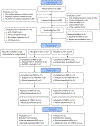Changes in functional connectivity with cognitive behavioral therapy for social anxiety disorder predict outcomes at follow-up
- PMID: 32276238
- PMCID: PMC7329578
- DOI: 10.1016/j.brat.2020.103612
Changes in functional connectivity with cognitive behavioral therapy for social anxiety disorder predict outcomes at follow-up
Abstract
Approximately half of individuals with Social Anxiety Disorder (SAD) treated with psychological intervention do not achieve clinically significant improvement or retain long-term gains. Neurobiological models of SAD propose that disruptions in functioning of amygdala-prefrontal circuitry is implicated in short-term treatment response. However, whether treatment-related changes in functional connectivity predict long-term well-being after psychotherapy is unknown. Patients with SAD completed an incidental emotion regulation task during fMRI before and after treatment with cognitive behavioral therapy or acceptance and commitment therapy (n = 23, collapsed across groups). Psychophysiological interaction analyses using amygdala seed regions were conducted to assess changes in functional connectivity from pre-to post-treatment that predicted symptom change from 6 to 12-month follow-up. Negative change (i.e., greater inverse/weaker positive) in amygdala connectivity with the dorsomedial prefrontal cortex (dmPFC) and dorsal anterior cingulate cortex (dACC) predicted greater symptom reduction during follow-up. Positive change in amygdala connectivity with the cerebellum, fusiform gyrus, and pre-central and post-central gyri predicted less symptom reduction (e.g., no change or worsening). Results suggest that strengthened amygdala connectivity with regulatory regions may promote better long-term outcomes, whereas changes with visual and sensorimotor regions may represent sensitization to emotion-related cues, conferring poorer outcomes. Clinical implications for treatment personalization are discussed, should effects replicate in larger samples.
Keywords: Amygdala; Emotion regulation; Long-term treatment response; Prefrontal cortex; fMRI.
Copyright © 2020 Elsevier Ltd. All rights reserved.
Figures




Similar articles
-
Treatment for social anxiety disorder alters functional connectivity in emotion regulation neural circuitry.Psychiatry Res Neuroimaging. 2017 Mar 30;261:44-51. doi: 10.1016/j.pscychresns.2017.01.005. Epub 2017 Jan 16. Psychiatry Res Neuroimaging. 2017. PMID: 28129555 Free PMC article. Clinical Trial.
-
Neural connectivity during affect labeling predicts treatment response to psychological therapies for social anxiety disorder.J Affect Disord. 2019 Jan 1;242:105-110. doi: 10.1016/j.jad.2018.08.016. Epub 2018 Aug 18. J Affect Disord. 2019. PMID: 30173058 Free PMC article.
-
Group cognitive behavioral therapy modulates the resting-state functional connectivity of amygdala-related network in patients with generalized social anxiety disorder.BMC Psychiatry. 2016 Jun 13;16:198. doi: 10.1186/s12888-016-0904-8. BMC Psychiatry. 2016. PMID: 27296506 Free PMC article.
-
Neuroimaging Predictors and Mechanisms of Treatment Response in Social Anxiety Disorder: an Overview of the Amygdala.Curr Psychiatry Rep. 2018 Aug 28;20(10):89. doi: 10.1007/s11920-018-0948-1. Curr Psychiatry Rep. 2018. PMID: 30155657 Free PMC article. Review.
-
Neural Circuitry of Impaired Emotion Regulation in Substance Use Disorders.Am J Psychiatry. 2016 Apr 1;173(4):344-61. doi: 10.1176/appi.ajp.2015.15060710. Epub 2016 Jan 15. Am J Psychiatry. 2016. PMID: 26771738 Free PMC article. Review.
Cited by
-
Large-scale dysfunctional white matter and grey matter networks in patients with social anxiety disorder.iScience. 2022 Sep 8;25(10):105094. doi: 10.1016/j.isci.2022.105094. eCollection 2022 Oct 21. iScience. 2022. PMID: 36185352 Free PMC article.
-
Imaging the cerebellum in post-traumatic stress and anxiety disorders: a mini-review.Front Syst Neurosci. 2023 Aug 14;17:1197350. doi: 10.3389/fnsys.2023.1197350. eCollection 2023. Front Syst Neurosci. 2023. PMID: 37645454 Free PMC article. Review.
-
The short- and long-term effects of cognitive behavioral therapy on the glycemic control of diabetic patients: a systematic review and meta-analysis.Biopsychosoc Med. 2023 May 8;17(1):18. doi: 10.1186/s13030-023-00274-5. Biopsychosoc Med. 2023. PMID: 37150826 Free PMC article. Review.
-
Neural Mechanisms of Cognitive Behavioral Therapy Efficacy in Anxiety Disorders: A Scoping Review of fMRI-Based Studies That Tested the Dual Model.Life (Basel). 2025 Mar 18;15(3):493. doi: 10.3390/life15030493. Life (Basel). 2025. PMID: 40141837 Free PMC article. Review.
-
Efficacy of CBT, intensified tDCS and their combination for reducing clinical symptoms and improving quality of life in social anxiety disorder with comorbid depression: a randomized controlled trial.BMC Psychiatry. 2025 Apr 29;25(1):438. doi: 10.1186/s12888-025-06866-5. BMC Psychiatry. 2025. PMID: 40301811 Free PMC article. Clinical Trial.
References
-
- Banks SJ, Eddy KT, Angstadt M, Nathan PJ, & Phan KL (2007). Amygdala–frontal connectivity during emotion regulation. Social Cognitive and Affective Neuroscience, 2(4), 303–312. Retrieved from http://scan.oxfordjournals.org/content/2/4/303.short - PMC - PubMed
-
- Brown TA, Barlow DH, & DiNardo PA (1994). Anxiety Disorders Interview Schedule for DSM-IV (ADIS-IV): Client Interview Schedule/. Graywind Publications Incorporated; Retrieved from https://books.google.com/books?hl=en&lr=&id=NSsWKR5tG8AC&oi=fnd&pg=PP2&d...

